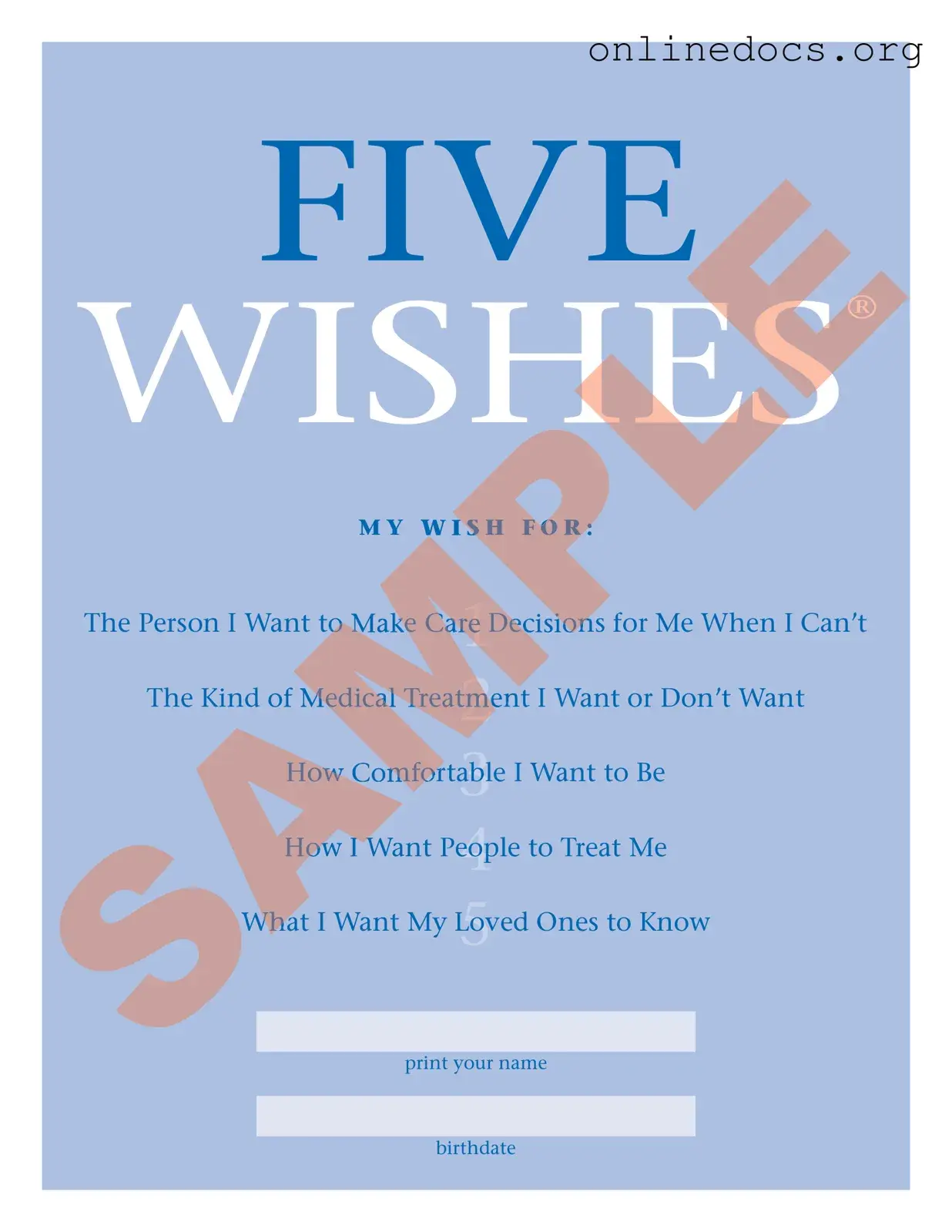The Five Wishes document is similar to a living will, which is a legal document that outlines an individual's preferences for medical treatment in the event they become unable to communicate their wishes. Like Five Wishes, a living will allows individuals to specify the types of medical care they would or would not want, such as resuscitation efforts or life support. Both documents serve to guide healthcare providers and family members in making decisions that align with the patient's values and preferences during critical health situations.
Another document comparable to Five Wishes is a durable power of attorney for healthcare. This document designates a specific person to make healthcare decisions on behalf of an individual if they are incapacitated. Similar to Five Wishes, it emphasizes the importance of appointing a trusted individual who understands the patient’s wishes. While Five Wishes provides detailed instructions about care preferences, a durable power of attorney focuses more on the authority granted to the designated person.
Advance directives are also akin to Five Wishes. These are legal documents that communicate a person's healthcare preferences when they cannot express them. Like Five Wishes, advance directives can include specific instructions regarding medical treatment and appoint a healthcare proxy. The key difference lies in the format and level of detail; Five Wishes offers a more comprehensive approach that addresses emotional and spiritual needs alongside medical preferences.
Health care proxies serve a similar function to the designated agent in Five Wishes. A health care proxy is a person chosen to make medical decisions for someone who is unable to do so. This document ensures that the individual's healthcare preferences are honored, much like the Five Wishes document. Both emphasize the importance of having a trusted advocate who can navigate complex medical decisions in alignment with the patient’s wishes.
When considering documentation for trailer ownership, it is essential to understand the various forms that serve specific purposes. One important resource is the https://fillpdf-forms.com, where you can find the necessary forms needed to execute a seamless transfer of trailer ownership legally. Understanding these forms can simplify the process for both sellers and buyers, ensuring all legal standards are met efficiently.
Do Not Resuscitate (DNR) orders are another important document that shares similarities with Five Wishes. A DNR order specifically instructs medical personnel not to perform CPR or other resuscitation efforts if a person’s heart stops or they stop breathing. While Five Wishes provides broader directives about overall care preferences, a DNR is a specific instruction that can be included in a comprehensive plan for end-of-life care.
POLST (Physician Orders for Life-Sustaining Treatment) forms are also comparable to Five Wishes. POLST is a medical order that outlines a patient's preferences for life-sustaining treatments and is signed by a physician. Like Five Wishes, POLST ensures that healthcare providers are aware of and respect the patient's wishes regarding treatment options. The main distinction is that POLST is a medical order, while Five Wishes is a more personal document that includes emotional and spiritual considerations.
Advance Care Planning (ACP) documents encompass a range of tools, including Five Wishes, to help individuals express their healthcare preferences. ACP involves discussions and decisions about future medical care, ensuring that individuals' wishes are understood and respected. Five Wishes fits into this broader category by providing a structured format for expressing specific desires about medical treatment and personal care.
Finally, a letter of intent can serve as a supplementary document to Five Wishes. This informal document allows individuals to communicate their wishes and preferences regarding healthcare and end-of-life decisions to family members and healthcare providers. While it lacks the legal weight of Five Wishes, it can provide valuable context and additional information about a person's values and desires, reinforcing the directives outlined in Five Wishes.
